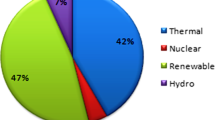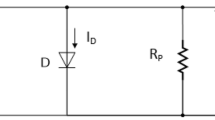Abstract
Currently, the majority of the country has moved to renewable energy sources for electricity generation, and power companies are concentrating their efforts on renewable resources. Solar, wind, hydropower, and biomass are examples of renewable resources; of these, due to a lack of non-renewable resources, the solar industry is expanding. All year long, solar electricity is available, and it creates a calm, quiet atmosphere. The majority of large and small companies, as well as individual consumers, have shifted to PV solar cells for electricity generation. A trustworthy and precise simulation design of a photovoltaic system prior to installation is required to predict a photovoltaic system’s performance. The current research aims to build models for solar PV systems with one, two, and three diodes and determine which model is most appropriate for each environmental circumstance to forecast performance accurately. By contrasting the experimental data of solar panel with simulated results of single-, double-, and triple-diode models, this study examines the accuracy of each model. These models’ comparative performance study has been done using the MATLAB/Simulink, taking into account the influence of changing model parameters and the performance of the models under varying climatic circumstances. These models, despite their simplicity, are quite sensitive and react to even a little change in temperature and irradiance. Under conditions of low solar irradiance or shading conditions, three-diode photovoltaic models are shown to be more accurate. We can forecast the power output of solar photovoltaic systems under changeable input circumstances by understanding the I-V curves with the help of the performance assessment of the models used in this work.

























Similar content being viewed by others
Data availability
Not applicable.
References
Alkahtani M, Wu Z, Kuka CS, Alahammad MS, Ni K (2020) A novel PV array `reconfiguration algorithm approach to optimising power generation across non-uniformly aged PV arrays by merely repositioning. J Multidiscip Sci J 3(1):32–53. https://doi.org/10.3390/j3010005
Central Eectricity Authority (2021) All India installed capacity (in MW) of power stations installed capacity (in Mw) of power utilities in the states/Uts located. Central Eectricity Authority, Minist Power 4:1–7
Diab AAZ, Sultan HM, Aljendy R, Al-Sumaiti AS, Shoyama M, Ali ZM (2020) Tree growth based optimization algorithm for parameter extraction of different models of photovoltaic cells and modules. IEEE Access 8:119668–119687. https://doi.org/10.1109/ACCESS.2020.3005236
El Hammoumi A, Chtita S, Motahhir S, El Ghzizal A (2022) Solar PV energy: from material to use, and the most commonly used techniques to maximize the power output of PV systems: a focus on solar trackers and floating solar panels. Energy Rep 8(November):11992–12010. https://doi.org/10.1016/j.egyr.2022.09.054
Fahim SR, Hasanien HM, Turky RA, Aleem SHEA, Ćalasan M (2022) A comprehensive review of photovoltaic modules models and algorithms used in parameter extraction. Energies 15:23. https://doi.org/10.3390/en15238941
Fan Y, Wang P, Heidari AA, Chen H, Turabieh H, Mafarja M (2022) Random reselection particle swarm optimization for optimal design of solar photovoltaic modules. Energy 239:121865. https://doi.org/10.1016/j.energy.2021.121865
Gobichettipalayam Shanmugam SK, Sakthivel TS, Gaftar BA, Iyyappan P, Sathyamurthy R (2022) Modeling and simulation of single- and double-diode PV solar cell model for renewable energy power solution. Environ Sci Pollut Res 29(3):4414–4430. https://doi.org/10.1007/s11356-021-15870-7
Hasan K, Yousuf SB, Tushar MSHK, Das BK, Das P, Islam MS (2022) Effects of different environmental and operational factors on the PV performance: a comprehensive review. Energy Sci Eng 10(2):656–675. https://doi.org/10.1002/ese3.1043
Huang H, Bristow N, David TW, Kettle J, Todeschini G (2020) A novel computational model for organic PV cells and modules. Int J Smart Grid 4:4. https://doi.org/10.20508/ijsmartgrid.v4i4.127.g105
Humada AM, Darweesh SY, Mohammed KG, Kamil M, Mohammed SF, Kasim NK, Tahseen TA, Awad OI, Mekhilef S (2020). Modeling of PV system and parameter extraction based on experimental data: review and investigation. Solar Energy 199:742–760. https://doi.org/10.1016/j.solener.2020.02.068
Kanimozhi G, Kumar H, Satyanarayana N (2022) A novel hybrid approach for the optimization of double-diode model parameters of solar cell. Int J Energy Res 46(11):14766–14778. https://doi.org/10.1002/er.8180
Khan SA, Ahmad S, Sarwar A, Tariq M, Ahmad J, Asim M, Soliman AT, Hossain MA (2021) Chaos induced coyote algorithm (Cica) for extracting the parameters in a single, double, and three diode model of a mono-crystalline, polycrystalline, and a thin-film solar pv cell. Electron (Switzerland) 10:17. https://doi.org/10.3390/electronics10172094
Ndi FE, Perabi SN, Ndjakomo SE, Ondoua Abessolo G, Mengounou Mengata G (2021) Estimation of single-diode and two diode solar cell parameters by equilibrium optimizer method. Energy Rep 7:4761–4768. https://doi.org/10.1016/j.egyr.2021.07.025
Premkumar M, Jangir P, Kumar C, Sundarsingh Jebaseelan SDT, Alhelou HH, Madurai Elavarasan R, Chen H (2022) Constraint estimation in three-diode solar photovoltaic model using Gaussian and Cauchy mutation-based hunger games search optimizer and enhanced Newton-Raphson method. IET Renew Power Gener 16(8):1733–1772. https://doi.org/10.1049/rpg2.12475
Premkumar M, Subramaniam U, Babu TS, Elavarasan RM, Mihet-Popa L (2020) Evaluation of mathematical model to characterize the performance of conventional and hybrid PV array topologies under static and dynamic shading patterns. Energies 13(12):3216. https://doi.org/10.3390/en13123216
Xiao W (2017) Photovoltaic power system: modeling, design, and control. Sidney: John Wiley & Sons
Yaqoob SJ, Saleh AL, Motahhir S, Agyekum EB, Nayyar A, Qureshi B (2021). Author Correction: Comparative study with practical validation of photovoltaic monocrystalline module for single and double diode models (Scientific Reports, (2021), 11, 1, (19153), https://doi.org/10.1038/s41598-021-98593-6). Scientific Reports, 11(1), 1–15. https://doi.org/10.1038/s41598-021-01357-5
Yousri D, Fathy A, Rezk H, Babu TS, Berber MR (2021) A reliable approach for modeling the photovoltaic system under partial shading conditions using three diode model and hybrid marine predators-slime mould algorithm. Energy Convers Manage 243(May):114269. https://doi.org/10.1016/j.enconman.2021.114269
Acknowledgements
Dr. Amitesh Kumar would like to thank DST SERB for providing a start-up research grant for this project to conduct research at NIT Patna. Mr. Rahul Kumar would like to thank the Department of Electrical Engineering, NIT Patna for providing research facilities.
Funding
The authors received financial assistance from the Department of Science and Technology (DST), Government. of India provided under DST SERB Project (File No. SRG/2021/002110) to carry out the present work.
Author information
Authors and Affiliations
Contributions
RK: conceptualization, methodology, software, data curation, visualization, investigation, writing—original draft preparation. AK: conceptualization, methodology, supervision, reviewing and editing, visualization, investigation.
Corresponding author
Ethics declarations
Ethics approval
Not applicable.
Consent to participate
Not applicable.
Consent for publication
Not applicable.
Competing interests
The authors declare no competing interests.
Additional information
Responsible Editor: Philippe Garrigues
Publisher's Note
Springer Nature remains neutral with regard to jurisdictional claims in published maps and institutional affiliations.
Rights and permissions
Springer Nature or its licensor (e.g. a society or other partner) holds exclusive rights to this article under a publishing agreement with the author(s) or other rightsholder(s); author self-archiving of the accepted manuscript version of this article is solely governed by the terms of such publishing agreement and applicable law.
About this article
Cite this article
Kumar, R., Kumar, A. Effective-diode-based analysis of industrial solar photovoltaic panel by utilizing novel three-diode solar cell model against conventional single and double solar cell. Environ Sci Pollut Res 31, 25356–25372 (2024). https://doi.org/10.1007/s11356-024-32474-z
Received:
Accepted:
Published:
Issue Date:
DOI: https://doi.org/10.1007/s11356-024-32474-z




